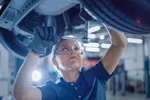The traditional 'stock-push' system has given car manufacturers a method that allows them to minimise the cost of production by achieving planned stable production volumes, which are pre-sold to dealers. Over-production, or non-successful cars, are taken care of by dealer discounts, bonuses or other action at the wholesaling level. It puts a lot of financial pressure on dealers and the customers' requirements are not a key element in the running of the system. A move to lean distribution should bring a more flexible system which is more customer-oriented as regards car configuration and delivery time. The use of lean distribution on a large scale is said to generate important savings to all the actors (sic) involved in the distribution chain.
Internet
Consumers are more and more willing to purchase products via the internet – car manufacturers still have a cautions (sic) approach. The internet generates a new category of entrepreneurs wishing to act as intermediaries for consumers facilitating the purchase of their cars. They might want to develop it at a later stage as a sales tool. For the moment, contrary to other retail sectors, none of the internet-based operators in Europe are able to sell cars directly to consumers. They have to go through the dealer network and thus the existing distribution system.
Intra-brand competition
This relies on a number of instruments available to dealerships which are members of the distribution network of a manufacturer. Intra-brand competition among dealers from different EU countries relies basically on price differentials for new cars across the Community, and should be fostered by an increasing awareness on the part of consumers, prompting them to engage in parallel trade. Competition is limited by the ban on personalised advertising outside the contract territory and by the ban on selling undertakings not belonging to the network which carries out resale activity.
Imports
Although a core aim is to give every European citizen the right to purchase a car in an EU country of their choice, car buyers still face difficulties when they try to purchase new vehicles in another member state. Manufacturers and their importers can use a system of sales targets allowed under the regulation and subsequent allocation of production output to their dealers to organise distribution in a way which can lead to discrimination against cross-border sales as compared with national sales.















Login to comment
Comments
No comments have been made yet.